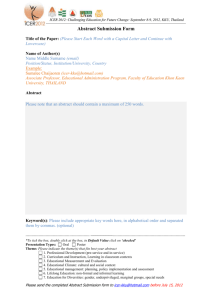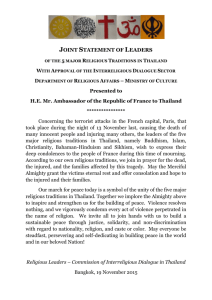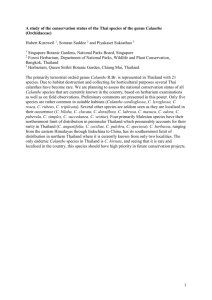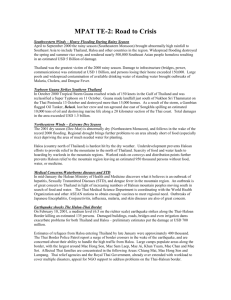Schistura aurantiaca , a new species from the Mae Khlong basin
advertisement
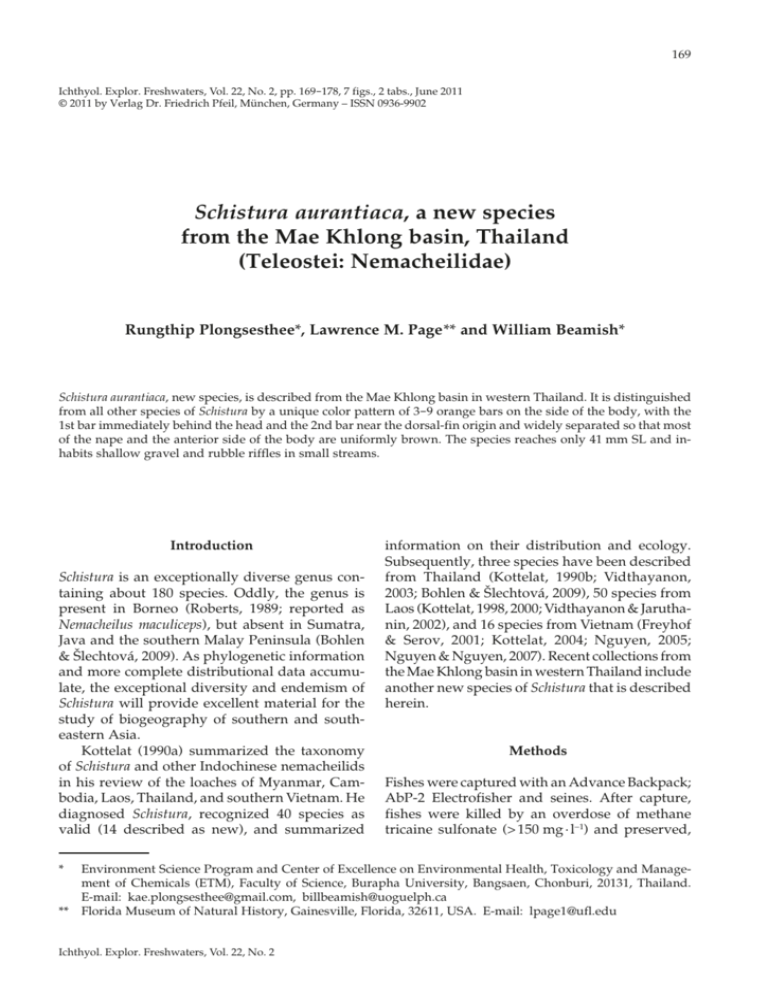
169 Ichthyol. Explor. Freshwaters, Vol. 22, No. 2, pp. 169-178, 7 figs., 2 tabs., June 2011 © 2011 by Verlag Dr. Friedrich Pfeil, München, Germany – ISSN 0936-9902 Schistura aurantiaca, a new species from the Mae Khlong basin, Thailand (Teleostei: Nemacheilidae) Rungthip Plongsesthee*, Lawrence M. Page** and William Beamish* Schistura aurantiaca, new species, is described from the Mae Khlong basin in western Thailand. It is distinguished from all other species of Schistura by a unique color pattern of 3-9 orange bars on the side of the body, with the 1st bar immediately behind the head and the 2nd bar near the dorsal-fin origin and widely separated so that most of the nape and the anterior side of the body are uniformly brown. The species reaches only 41 mm SL and inhabits shallow gravel and rubble riffles in small streams. Introduction Schistura is an exceptionally diverse genus containing about 180 species. Oddly, the genus is present in Borneo (Roberts, 1989; reported as Nemacheilus maculiceps), but absent in Sumatra, Java and the southern Malay Peninsula (Bohlen & Šlechtová, 2009). As phylogenetic information and more complete distributional data accumulate, the exceptional diversity and endemism of Schistura will provide excellent material for the study of biogeography of southern and southeastern Asia. Kottelat (1990a) summarized the taxonomy of Schistura and other Indochinese nemacheilids in his review of the loaches of Myanmar, Cambodia, Laos, Thailand, and southern Vietnam. He diagnosed Schistura, recognized 40 species as valid (14 described as new), and summarized * information on their distribution and ecology. Subsequently, three species have been described from Thailand (Kottelat, 1990b; Vidthayanon, 2003; Bohlen & Šlechtová, 2009), 50 species from Laos (Kottelat, 1998, 2000; Vidthayanon & Jaruthanin, 2002), and 16 species from Vietnam (Freyhof & Serov, 2001; Kottelat, 2004; Nguyen, 2005; Nguyen & Nguyen, 2007). Recent collections from the Mae Khlong basin in western Thailand include another new species of Schistura that is described herein. Methods Fishes were captured with an Advance Backpack; AbP-2 Electrofisher and seines. After capture, fishes were killed by an overdose of methane tricaine sulfonate (> 150 mg · l−1) and preserved, Environment Science Program and Center of Excellence on Environmental Health, Toxicology and Management of Chemicals (ETM), Faculty of Science, Burapha University, Bangsaen, Chonburi, 20131, Thailand. E-mail: kae.plongsesthee@gmail.com, billbeamish@uoguelph.ca ** Florida Museum of Natural History, Gainesville, Florida, 32611, USA. E-mail: lpage1@ufl.edu Ichthyol. Explor. Freshwaters, Vol. 22, No. 2 170 Fig. 1. Schistura aurantiaca, Burapha University, uncat., 33.7 mm SL, female, freshly preserved; Thailand: Kanchanaburi Prov.: Khayeng River; 25 Mar 2010. first in 10 % formalin for 7 days and then in 70 % ethanol for permanent preservation. At each site, depth and velocity were measured and recorded as the average of 3-5 measurements made at approximately equal intervals across a transverse transect located at about the mid-length of a site. Velocity was measured with a propeller current meter (± 0.1 cm · s−1) at mid-depth. Canopy was estimated visually and recorded as percentage of complete cover. Regularly calibrated meters were used to measure temperature (± 0.1 C), conductivity (± 10 μS · cm−1), pH (± 0.1) and dissolved oxygen (± 0.01 mg · l−1). Other chemical factors were measured as described in APHA, 1992 and Tongnunui & Beamish (2009). Elevation was measured with a Global Positioning System meter, GPS (± 10 m). All measurements and counts follow Kottelat (1990a) except head length is from the posterior edge of the opercle to the tip of the snout, and body width is at the dorsal-fin origin. Measurements were made point-to-point with dial calipers to the nearest 0.1 mm. Meristic values for the holotype are indicated by an asterisk. Photographs were taken of live and freshly preserved specimens using a Nikon COOLPIX P5100 camera, and of preserved specimens using a Visionary Digital (Palmyra, Virginia) with a Canon 5D camera at the Florida Museum of Natural History. Specimens examined are from: MCZ, Museum of Comparative Zoology, Harvard University; NIFI, National Inland Fisheries Institute, Bangkok; UF, University of Florida; USNM, National Museum of Natural History, Washington; and ZRC, Zoological Reference Collection, National University of Singapore. Schistura aurantiaca, new species (Figs. 1-2) Holotype. UF 178532, 36.3 mm SL; Thailand: Kanchanaburi Prov.: Thong Pha Phum, Mae Khlong basin, Kwai Noi River system, Khayeng River at Route 3272 bridge, 14°39'35" N 98°32'01" E; W. Tangjitjaroen & L. M. Page, 3 Jan 2010. Paratypes. Thailand: Kanchanaburi Prov.: Mae Khlong basin, Kwai Noi River system: UF 176400, 2, 32.0-40.8 mm SL; same data as holotype. – UF 178529 1, 35.9 mm SL; NIFI 3972, 2, 35.9-35.9 mm SL; USNM 398673, 2, 35.8-40.0 mm SL; ZRC 52053, 2, 25.8-34.5 mm SL; Khayeng River, 14°33'22" N 98°34'20" E; R. Plongsesthee & P. Tookampha, 6 Jun 2010. – UF 173048, 2, 29.6-37.0 mm SL; Kwai Noi River, stream near km 32 on Route 323, 14°58' 17" N 98°38'24" E; W. Tangjitjaroen, J. C. Havird & L. M. Page, 12 Jun 2008. – UF 173049, 1, 31.8 mm SL; Lin Tin River, Route 323 at km 95, near Sai Yok, 14°33'44" N 98°47'16" E; W. Tangjitjaroen, J. C. Havird & L. M. Page, 12 Jun 2008. – UF 176388, 6, 20.1-32.9 mm SL; Kring Ta Ko River, 14°45'10" N 98°30'02" E; P. Chanintarapoomi, R. Beamish, W. Tangjitjaroen & L. M. Page, 2 Jan 2010. – UF 176447, 4, 24.3-30.3 mm SL; Ban Rai River, near Tong Pha Phum, 14°43'10" N 98°30'21" E; P. Chanintarapoomi, R. Beamish, W. Tangjitjaroen & L. M. Page, 2 Jan 2010. – UF 176461, 1, 27.3 mm SL; Lin Tin River, Route 323 at km 95, 14°32'16" N 98°47'16" E; W. Tangjitjaroen & L. M. Page, 1 Jan 2010. – UF 176575, 1, 21.0 mm SL; Ban Rai River, near Tong Pha Phum, 14°42'49" N 98°31'26" E; P. Chanintarapoomi, R. Beamish, W. Tangjitjaroen & L. M. Page, 2 Jan 2010. Plongsesthee et al.: Schistura aurantiaca 171 a b c d e Fig. 2. Schistura aurantiaca, a, UF 178532, holotype, 36.3 mm SL; Thailand: Kanchanaburi Prov.: Khayeng River near Thong Pha Phum; b, UF 176447, paratype, 30.3 mm SL; Thailand: Kanchanaburi Prov.: Ban Rai River near Tong Pha Phum; c-e, UF 176400, paratype, 40.8 mm SL; same data as holotype. Ichthyol. Explor. Freshwaters, Vol. 22, No. 2 172 Fig. 3. Mouth of Schistura aurantiaca, UF 178529, 35.9 mm SL. Scale bar 1 mm. Other material examined. Burapha University, uncat., 15, 31.9-39.5 mm SL; Thailand: Kanchanaburi Prov.: Khayeng River, 14°33'22" N 98°34'20" E; R. Plongsesthee & P. Tookampha, 22 Apr 2010. – Burapha University, uncat., 10, 31.3-39.7 mm SL; same locality; R. Plongsesthee & P. Tookampha, 25 Apr 2010. Diagnosis. Member of genus Schistura as defined by Kottelat (1990a). Schistura aurantiaca is distinguished from all other species of Schistura by unique color pattern of 3-9 orange bars on side of body; 1st bar immediately behind head, 2nd bar near dorsal-fin origin; most of nape and anterior side of body uniformly brown (Fig. 1). Description. Body shape and variation in color pattern shown in Figures 1 and 2. Morphometric data are in Table 1. Largest specimen 40.8 mm SL, 49.8 mm TL (UF 176400). Slender body; profile of snout and head moderately pointed. Body depth nearly uniform throughout, slightly deeper near dorsal-fin origin than at caudal peduncle. Head depressed; eyes near dorsal profile, directed dorsolaterally. Body barely compressed; depth slightly larger than body width. Dorsal-fin origin over to slightly behind pelvic-fin origin. Pectoral fin reaching over half distance from pectoral-fin base to pelvic-fin base. Pelvic fin overlapping anus, reaching over half distance from pelvic-fin base to anal-fin origin. No axillary pelvic lobe. Anal fin not reaching caudal fin. Margin of dorsal and anal fins convex. Caudal fin slightly to moderately emarginate. Body entirely scaled, except scales absent or deeply embedded on breast. Lateral scale row with 86-104 scales (N = 9); lateral line incomplete with 6-26 pores (mode = 20) (34 specimens), extending on most specimens to vertical at origin of dorsal fin. Dorsal fin iv 7 1/2 (27*) or iv 8 1/2 (1); anal fin iii 5 1/2 (28*); pectoral fin 9 (4) or 10 (24*); pelvic fin 7 (3) or 8 (25*); caudal fin 9 branched rays in upper half (27*), 8 branched rays in lower half (27*). Cephalic lateral-line system in holotype and two paratypes (UF 176400) with 7 supraorbital pores, 4 + 9 infraorbital, 9 preoperculomandibular and 3 supratemporal pores. Table 1. Morphometric data for Schistura aurantiaca. Range and mean do not include data on the holotype. holotype range (N = 27) mean ± SD Standard length (mm) 36.3 31.3-39.7 36.2 ± 2.6 Percentage of standard length Head length Predorsal length Snout length Prepelvic length Preanal length Body depth Body width Caudal-peduncle depth Caudal-peduncle length Pectoral-fin length Pelvic-fin length 22.1 54.7 8.8 49.6 73.9 15.0 11.6 13.0 15.4 16.7 17.8 19.9-26.6 51.9-59.2 8.2-11.2 51.0-56.4 71.4-80.1 14.1-19.0 12.3-16.0 12.5-16.5 11.7-16.0 17.2-20.9 15.7-18.8 22.9 ± 1.7 55.2 ± 1.5 9.7 ± 0.9 52.9 ± 1.4 77.4 ± 2.3 16.5 ± 1.1 14.5 ± 1.0 13.4 ± 0.9 14.3 ± 0.8 18.7 ± 0.9 17.2 ± 0.8 Percentage of head length Eye diameter Interorbital width 16.7 29.5 12.6-17.6 23.0-40.5 15.6 ± 1.6 31.9 ± 4.6 Plongsesthee et al.: Schistura aurantiaca 173 Lips moderately thick, pleated, covered with unculi; upper lip without median incision; lower lip with median interruption (Fig. 3). Processus dentiformis present. Barbels covered with unculi. Inner rostral barbel reaching to corner of mouth; outer rostral barbel reaching to front margin of eye. Maxillary barbel reaching to or slightly past vertical at rear margin of eye. Intestine with sharp bend just posterior to stomach, then turns sharply posterior (Fig. 4). Anterior nostril with long pointed flap reaching to eye. No apparent sexual dimorphism. Color in life. Head brown; orange bar at rear margin of top of head extends ventrally behind opercle and onto pectoral fin. Black preorbital bar extends onto snout almost to nasal barbel. Snout, upper lip and anterior part of lower lip dusky black. Body with 3-9 narrow orange bars on brown side; bars extending onto dorsum and venter (Figs. 1-2). First bar immediately behind head; 2nd bar usually just in front of dorsal fin; most of nape and anterior side uniformly brown. Third, and sometimes 4th, bar under dorsal fin; bar (sometimes absent) near base of caudal fin typically wider than other bars. Usually thin orange stripe along dorsal midline, most prominent on nape. Bold black bar at base of caudal fin. Dorsal fin orange at base, black band medially (pigment on rays), clear margin; large black blotch anteriorly at base of fin. Pectoral, pelvic and anal fins yellow-orange. Caudal fin orange, sometimes with 1-2 dusky black bands. Characteristic color pattern of adult apparent in smallest specimens examined (20-25 mm SL), although light bars on side of body slightly wider in relation to dark interspaces than in Fig. 4. Digestive tract of Schistura aurantiaca, Burapha University, uncat., 39.7 mm SL, female; Khayeng River, 14°33'22" N, 98°34'20" E, 25 Apr 2010. Scale bar 1 mm. larger specimens. Black medial band on dorsal fin and dusky black bands on caudal fin of individuals over 30 mm present only as black spots on smaller specimens. Comparisons. Using the key in Kottelat (1990a), S. aurantiaca would key out to Schistura laterimaculata. However, S. laterimaculata has a different color pattern including 5-7 horizontally elongate black blotches on the side of the body, and 12 pectoral-fin rays (10 in S. aurantiaca). Schistura aurantiaca is more similar to S. cincticauda, S. paucicincta, and S. robertsi (Table 2), but is easily separated from these species by the distinctive color pattern. In addition, S. cincticauda and S. robertsi have usually 9 pectoral-fin rays (vs. 10 in S. aurantiaca) and 7 pelvic-fin rays (vs. 8 in S. aurantiaca); and S. paucicincta has 8 Table 2. Characteristics of Schistura aurantiaca and phenotypically similar species with an incomplete lateral line. Data are from Kottelat (1990a) and material examined. S. aurantiaca S. cincticauda S. daubentoni S. laterimaculata S. paucicincta S. robertsi absent absent absent absent (or minute) 12 8 9/8 53 present absent 10 8 8/7 29 9 7 8-9/8 56 Suborbital flap absent absent Axillary lobe on pelvic fin absent absent apparently absent absent 10 8 9/8 41 9 7 9/8 50 9-10 7 8/8 29 Modal no. pectoral rays Modal no. pelvic rays Modal no. caudal rays: upper/lower Maximum size, mm Ichthyol. Explor. Freshwaters, Vol. 22, No. 2 174 98°20' E incomplete, reaching only to the dorsal fin with 9-24 pores), and a larger size, to 59 mm SL. Schistura desmotes modally has 8 1/2 dorsal rays (vs. 7 1/2 in S. aurantiaca), a lateral line that is complete or reaching at least to anal fin (vs. incomplete, reaching only to dorsal fin with 9-24 pores), and a much larger size, to 67 mm SL. 98°40'E 15°00' N Vajiralongkorn Reservoir 14°40' N Etymology. The name, aurantiaca, Latin adjective for orange-colored, is in reference to the orange bars on this species. Kw a i No i 20° N Thailand 10° N 14°20' N 100° E N 0 20 km Fig. 5. Distribution of Schistura aurantiaca. Black dots represent localities for specimens examined. upper and 7 or 8 lower branched caudal-fin rays (vs. 9 upper and 8 lower rays in S. aurantiaca). Schistura paucicincta has an axillary lobe at the base of the pelvic fin (lobe absent in S. aurantiaca), and S. robertsi has a bold black mark on the lower lip on each side of the median interruption (vs. dusky spots in S. aurantiaca) (Fig. 3). Schistura paucifasciata and S. balteata are superficially similar in having narrow bars below the dorsal fin; however, the bars in these two species are black, not orange, and both species have an axillary lobe at the base of the pelvic fin. Schistura aurantiaca is sympatric with S. mahnerti and S. desmotes, but is easily separated from both by its color pattern, lack of an axillary lobe at the base of the pelvic fin and lack of a suborbital flap on the adult male. Also in S. aurantiaca, the anterior nostril has a long pointed flap reaching to the eye. In S. mahnerti and S. desmotes, the much shorter flap on the anterior nostril reaches only to the rear margin of the posterior nostril. In addition, S. mahnerti has a lateral line that is complete to the caudal fin with 88-101 pores (vs. Distribution and habitat. Schistura aurantiaca is known only from the Kwai Noi, Mae Khlong basin, in the Thong Pha Phum District of Kanchanaburi Province, Thailand (Fig. 5). Most specimens have been taken in shallow gravel and rubble riffles in small streams in the upper reaches of the Kwai Noi (Fig. 6). Physical and chemical conditions were similar at all localities where S. aurantiaca was taken. Elevation varied from 240 to 308 m, stream width varied seasonally but ranged from 2.7 to 9.1 m, depth varied from 10 to 40 cm, velocity from 20 to 70 cm · s−1, and the substrate consisted of small to medium-sized rocks. Schistura aurantiaca usually was captured where riparian vegetation cover was > 70 percent but ranged from 30 to 90 percent. Water temperature varied seasonally from 20 to 26 °C. Water pH varied from 6.5 to 7.9. Water chemistry varied little seasonally and among the sites with oxygen at 7.4 to 8.5 mg · l−1. Ammonia, nitrate and total iron were all low, at approximately 0.01, < 0.03 and < 0.5 mg · l−1, respectively. Silica was high, consistent with the geology of the area, at 17-32 mg · l−1. Alkalinity was approximately 65 mg · l−1 except under flood conditions when it decreased to about 20 mg · l−1. Twenty-eight species of fishes were captured at the three stations where S. aurantiaca was taken most often: Brachydanio albolineatus, Danio sp., Devario regina, Garra sp., Mystacoleucus marginatus, Neolissochilus stracheyi, Puntius stoliczkanus, P. orphoides, Osteochilus vittatus, Rasbora paviana, Lepidocephalichthys berdmorei, Acanthocobitis zonalternans, A. botia, Nemacheilus pallidus, Schistura aurantiaca, S. desmotes, S. mahnerti, Homaloptera smithi, H. sexmaculata, Batasio tigrinus, Pseudomystus siamensis, Pterocryptis buccata, Amblyceps variegatum, Xenentodon cancila, Badis khwae, Mastacembelus armatus, Channa gachua, and unidentified goby (Gobiidae). Plongsesthee et al.: Schistura aurantiaca 175 Fig. 6. Typical habitat of Schistura aurantiaca; Thailand: Kanchanaburi Prov.: Khayeng River, near Tong Pha Phum, 6 Jun 2010. Discussion Publications on Schistura have contained little information on phylogenetic relationships. Kottelat (1990a) noted that relationships of most species of Schistura remain uncertain, but commented on two groups of species that share a number of morphological similarities. The first species group included S. cincticauda, S. robertsi, S. daubentoni, and “possibly S. paucicincta, S. paucifasciata, S. kangjupkhulensis and S. malaisei”. He noted that these species are small (less than 50 mm SL), and have a “reduced number of pelvic and pectoral rays, often with reduced number of caudal rays and reduced lateral line”. Schistura aurantiaca is similar phenotypically Fig. 7. Schistura mahnerti, UF 178531, 57.9 mm TL, male; Thailand: Kanchanaburi Prov.: Khayeng River. Ichthyol. Explor. Freshwaters, Vol. 22, No. 2 176 to S. cincticauda, S. daubentoni, S. paucicinta and S. robertsi in that it is small (known to reach only 41 mm SL), and has an incomplete lateral line and no suborbital flap. Although these characteristics may be derived, reduced meristic counts and loss of structures are common in fishes and in Schistura they may be the result of convergence rather than common ancestry. Aspects of the color pattern in Schistura may be better indicators of shared ancestry as they appear to be in the S. multifasciata group, discussed below. However, color patterns are variable ontogenetically and geographically in some species, and relationships among most species are likely to remain poorly known until DNA sequences or other genetic data are available. The closest relative of S. aurantiaca is unknown. A second species group recognized by Kottelat (1990a) included all species with the anterior bars divided; i. e., what can be called the S. multifasciata group, including S. poculi, S. vinciguerrae, S. mahnerti, S. bella, S. multifasciata, S. longa, and S. conirostris. These species are known from India, Indochina, and the Yunnan Province of China. Although not shown to be in the basin on any published distribution map, a species in the S. multifasciata group is syntopic with S. aurantiaca in the Kwai Noi. The geographically closest species in the group are S. poculi, S. vinciguerrae, S. mahnerti, and S. bella (Kottelat, 1990a). The species in the Mae Khlong is easily distinguished from S. vinciguerrae, known from the Irrawaddy and Salween basins in Myanmar and China, in having a suborbital flap, and from S. bella in the Mae Nam Kok of the Mekong basin in far northern Thailand, by lacking the light stripe above a dark stripe on the posterior half of the side. Schistura mahnerti occurs in the Salween basin in Mae Hong Son and Tak provinces, Thailand, adjacent to the upper reaches of the Mae Khlong, and is probably the species found in the Kwai Noi. However, specimens from the Kwai Noi (Fig. 7) are intermediate between those of S. mahnerti and S. poculi, which is found in the Mae Nam Ping, Mekong, and Salween river basins in northern Thailand, in that they usually have 8 or 9 branched upper caudal rays (6 of 32 specimens examined have 8, 24 have 9, and 2 have 7) and 7 or 8 branched lower caudal rays (7 have 7; 24 have 8, and 1 has 9). Schistura mahnerti was differentiated from S. poculi in its original description (Kottelat 1990a) by the presence of 9 upper and 8 lower branched caudal rays, compared to S. poculi, which has 8 upper and 7 lower branched caudal rays. Given the geographic proximity and the modal number of branched caudal rays, the Mae Khlong population is tentatively identified as S. mahnerti. Material examined. Schistura bella: USNM 295769, 10 paratypes, 31.7-38.1 mm SL; Thailand: Mekong basin: Chiang Mai Prov.: Kok River at Thaton; 26 Apr 1973. Schistura desmotes: Thailand: Ping River basin: Chiang Mai Prov.USNM 295777, 15, 29.3-45.3 mm SL; Ping River, near Chiang Dao, 60 km N Chiang Mai; 26 Apr 1973. Thailand: Mae Khlong basin: Kanchanaburi Prov.: UF 176413, 3, 27.1-34.7 mm SL; Kwai Noi River, Khayeng River, hwy 3272 bridge, 14°39'35" N 98°32'01" E; 3 Jan 2010. – USNM 295767, 13, 21.0-27.0 mm SL; Kwai Noi River between Kanchanaburi and Sai Yok; 13-14 Apr 1973. Schistura cincticauda: NIFI 2060, 3, 27.2-31.5 mm SL; Thailand: Salween River Basin: Tak Prov.: Jawang River, Amphoe Tha Song Yang; 20 Mar 1982. Schistura kentungensis: USNM 295774, 5, 41.357.5 mm SL; Thailand: Mekong basin: Chiang Mai Prov.: Pong Nam Ron District, cascading mountain stream, 8 km W Fang; 25 Apr 1973. Schistura kohchangensis: Thailand: Chantaburi Prov.: MCZ 56065, 4, 26.2-51.2 mm SL; Khao Soi Dao Wildlife Sanctuary; 19 Apr 1979. – UF 169919, 4, 34.5-48.4 mm SL; Klong Sato Noi, Changwat, 12°42'20" N 102°24'48" E; 7 Nov. 2007. Schistura maepaiensis: USNM 288472, 6 paratypes, 21.5-41.5 mm SL; Thailand: Mae Hong Son Prov.: Salween River at Mae Sahm Leap, W Mae Sariang; 30 Apr 1973. Schistura mahnerti: Thailand: Salween River basin: Mae Hong Son Prov.: NIFI 855, 1 paratype, 44.4 mm SL; Mae Sahm Leap, Amphoe Mae Sariang; 22 Jan 1981. – NIFI 864, 15 paratypes, 17.5-56.4 mm SL; Mae Sariang River, Mae Sariang District, Amphoe Mae Sariang; 29 May 1978. Thailand: Salween River basin: Tak Prov.: NIFI 876, 8 paratypes, 24.8-28.0 mm SL; Moei River, Ban Huai Pong, Amphoe Tha Song Yang; 10 Jun 1981. – USNM 288462, 6 paratypes, 21.5-55.6 mm SL; mountain stream, 5 km W Mae Sariang; 29 Apr 1973. Thailand: Mae Khlong basin: Kanchanaburi Prov.: NIFI 3056, 10 (of 14), 32.3-54.8 mm SL; Thung Yai Naresuan Wildlife Conservation Area; 4 Apr 1996. – NIFI 3082, 48, 32.765.5 mm SL; near Mae Khamin Waterfall; 4-5 Jan 1998. – UF 178531, 6, 48.5-58.7 mm SL; Khayeng River, near Tong Pha Phum, 14°33'22" N 98°34'20" E; 25 May 2010. Thailand: Gulf of Thailand basin: Prachuap Khiri Kan Prov.: UF 178530, 4, 53.1-74.0 mm SL; Bang Sapan, 11°14'24" N 99°21'27" E; 25 May 2010. Schistura poculi: Thailand: Ping River basin. Chiang Mai Prov.: MCZ 35525, holotype, 47.3 mm SL; MCZ 35526, 9 paratypes, 32.1-56.0 mm SL; Doi Angka; Apr 1937. – NIFI 2056, 4, 39.3-46.0 mm SL; Doi Inthanon Plongsesthee et al.: Schistura aurantiaca 177 Road, km 18; 22 Nov 1978. – NIFI 2870, 36, 28.9-48.8 mm SL; Amphoe Chiang Dao; BaAn Pingso; 14 Dec 1995. Thailand: Mekong basin: Chiang Mai Prov.: USNM 295779, 10 (of 20), 40.0-50.0 mm SL; Pong Nam Ron District, cascading mountain stream, 8 km W Fang; 25 Apr 1973. Thailand: Salween River basin: Mae Hong Son Prov.: NIFI 850, 54, 29.5-54.9 mm SL; Luang River, Amphoe Luang; 25 Mar 1981. – NIFI 854, 4, 31.0-38.9 mm SL; Mae La Ka, Nong Haeng, Tambon Muang Bon, Amphoe Khun Yuam; 25 Nov 1987. Schistura robertsi: Thailand: Songkhla Prov.:NIFI 2071, 3 paratypes, 38.2-56.0 mm SL; Ton Nga Chang Waterfall; 19 Mar 1984. Thailand: Phangnga Prov.: MCZ 47273, 13 paratypes, 21.4-38.3 mm SL; Nong Hong River near Phang Nga; 29 Jun 1970. – MCZ 61166, 1, 33.7 mm SL; same data as MCZ 47273. Thailand: Phuket Prov.: MCZ 49164, 23 paratypes, 13.4-32.9 mm SL; Ton Sai Waterfall, about 4 km E Thalang; 27 Jun 1970. Schistura spilota: MCZ 35552, 7, 55.7-74.9 mm SL; Thailand: Ping River basin: Chiang Mai Prov.: Doi Angka; Apr 1937 Schistura waltoni: Thailand: Ping River basin. Chiang Mai Prov.: MCZ 61165, 2, 48.5-52.8 mm; Doi Angka; Apr 1937. – NIFI 2851, 32, 35.6-96.7 mm SL; NIFI 2871, 38, 36.0-89.5 mm SL; Doi Luang, Amphoe Chiang Dao; 14 Dec 1995. – MCZ 35520, holotype of Noemacheilus obscurus, 63.5 mm SL; Doi Angka; Apr 1937. Acknowledgements We are grateful to the Biodiversity Research and Training Program (BRT) and Center of Excellence on Environmental Health, Toxicology and Management of Chemicals (ETM), Faculty of Science, Burapha University, for financial support. The logistical assistance provided by Visut Baimai and Rungsima Tantalaka was important and appreciated. We thank Prapawadee Tookampha, Chuntee Kongchaiya, Raphael Lagarde, Weerapongse Tangjitjaroen, Peangchai Chanintarapoomi, Patchara Nithirojpakdee, and Robert Beamish for assistance in the field, and the following individuals and institutions for loans of specimens and assistance during visits: Karsten Hartel, Museum of Comparative Zoology, Harvard University; Siriwan Suksri, National Inland Fisheries Institute, Bangkok; Jeff Williams, Jerry Finan, and Richard Vari, National Museum of Natural History, Smithsonian Institution, Washington; and Robert Robins and Randy Singer, University of Florida Museum of Natural History. Weerapongse Tangjitjaroen provided laboratory space at Chiang Mai University. Figure 3 is modified from a map graciously provided by Sampan Tongnunui. This project was supported in part by the U.S. National Science Foundation-funded All Catfish (DEB 0315963) and All Cypriniformes (DEB 1022720) Species Inventories. The National Science award, DEB 0845392, to David Reed provided the Visionary Digital (Palmyra, Virginia) system. Ichthyol. Explor. Freshwaters, Vol. 22, No. 2 Literature cited American Public Health Association (APHA). 1992. Standard methods for the examination of water and wastewater, 18th edition. American Public Health Association, American Water Works Association, and Water Pollution Control Federation, Washington, D.C, 959 pp. Bohlen, J. & V. Šlechtová. 2009. Schistura udomritthiruji, a new loach from southern Thailand (Cypriniformes: Nemacheilidae). Ichthyological Exploration of Freshwaters, 20: 319-324. Freyhof, J. & D. V. Serov. 2001. Nemacheiline loaches from Central Vietnam with descriptions of a new genus and 14 new species (Cypriniformes: Balitoridae). Ichthyological Exploration of Freshwaters, 12: 133-191. Kottelat, M. 1990a. Indochinese nemacheilines: A revision of nemacheiline loaches (Pisces: Cypriniformes) of Thailand, Burma, Laos, Cambodia and southern Viet Nam. Pfeil, München. 262 pp. — 1990b. New species and populations of cave nemacheilines in South and Southeast Asia (Osteichthyes: Balitoridae). Mémoires de Biospéologie, 17: 49-56. — 1998. Fishes of the Nam Theun and Xe Bangfai basins, Laos, with diagnoses of twenty-two new species (Teleostei: Cyprinidae, Balitoridae, Cobitidae, Coiidae and Odontobutidae). Ichthyological Exploration of Freshwaters, 9: 1-128. — 2000. Diagnoses of a new genus and 64 new species of fishes from Laos (Teleostei: Cyprinidae, Balitoridae, Bagridae, Syngnathidae, Chaudhuriidae and Tetraodontidae). Journal of South Asian Natural History, 5: 37–82. — 2004. Schistura spekuli, a new species of cave fishes from northern Vietnam (Teleostei: Balitoridae). Ichthyological Exploration of Freshwaters, 15: 187-191. Nguyen, V. H. 2005. Cá nuóc ngot Viêt Nam. Tâp II. Lop ca sun va bon lien bo cua nhom ca xuong (lien bo ca that, lien bo ca dang trich, tong bo ca dang chao va lien bo ca dang chep) [Freshwater fishes of Vietnam. Volume 2]. Nhà Xuât Ban Nông Nghiêp [Agriculture Publishing House], Hanoi, 759 pp. [In Vietnamese]. Nguyen, X. K. & H. D. Nguyen. 2007. A new species of genus Schistura from Pu Mat National Park, Nghe An Province, Vietnam. Tap Chi Sinh Hoc (Journal of Biology), 29: 17-21. Roberts, T. R. 1989. The freshwater fishes of western Borneo (Kalimantan Barat, Indonesia). Memoirs of the California Academy of Sciences, 14: 1-210. Tongnunui, S. & F. W. H. Beamish. 2009. Habitat and relative abundance of fishes in small rivers in eastern Thailand. Environmental Biology of Fishes, 85: 209-220. Vidthayanon, C. 2003. Schistura pridii, a new nemacheiline loach (Teleostei: Balitoridae) from Upper Chao Phraya drainage, northern Thailand. Ichthyological Exploration of Freshwaters, 14: 307-310. 178 Vidthayanon, C. & K. Jaruthanin. 2002. Schistura kaysonei, (Teleostei: Balitoridae) a new cave fish from the Khammouan karst, Laos PDR. Aqua, Journal of Ichthyology and Aquatic Biology, 6: 17-20. Received 12 September 2010 Revised 5 April 2011 Accepted 31 May 2011 Plongsesthee et al.: Schistura aurantiaca
